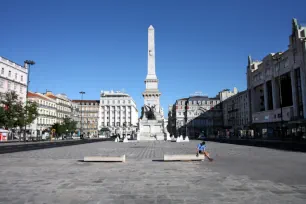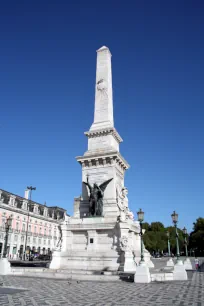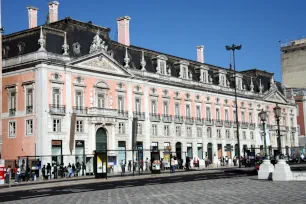Lisbon’s main boulevard, the Avenida da Libertade, starts at an oval-shaped square known as the Praça dos Restauradores. At its center stands a large obelisk, the Monumentos dos Restauradores.
Restauradores Monument

The obelisk was erected here in 1886 and commemorates the restoration of Portuguese Independence from Spain in 1640. Portugal had been under Spanish administration for sixty years when the Portuguese nobility started a revolt on December 1, 1640.
The revolt triggered the Restoration War – a twenty-eight-year war between Spain and Portugal – that ended with the Treaty of Lisbon, in which Spain recognized the sovereignty of Portugal.

The thirty-meter-tall (98 ft.) monument was designed by artist and architect António Tomás da Fonseca, who would later become director of the Museum of Ancient Arts. The bronze statues decorating the monument were created by sculptors Simões de Almeida and Alberto Nunes. The statue on the south side of the monument represents Liberty, the one on the other side represents Victory. Dates inscribed on the monument recall the decisive battles of the Restoration War.
Foz Palace
The largest and most important building bordering Praça dos Restauradores is Palácio Foz (Foz Palace), built in Baroque style between 1755 and 1777 for the marquis of Castelo-Melhor.


Its current Italianesque appearance is the result of a late eighteenth-century renovation by the Italian architect Francesco Saverio Fabri. The palace was originally named Palácio Castelo Melhor but later renamed to Palácio Foz for the marquis of Foz, who lived here in the nineteenth century.
The palace has a magnificent interior with pompous gilded decorations, marble pillars, wrought iron balconies and balustrades, painted ceilings and walls decorated with azulejo panels. The most impressive hall is the Sala dos Espelhos, a sumptuous mirror hall in Louis XIV style.
Eden Theater
Adjacent to the Foz Palace is one of Lisbon’s most beautiful Art Deco buildings: the former Teatro Eden (Eden Theater). The theater, designed by architects Cassiano Branco and Carlo Florencio Dias, opened in 1931 and soon became one of the city’s most important cinemas.
In 1989 the cinema closed its doors and remained empty until 2001, when it was converted into a hotel. The facade, with bas-reliefs, was kept mostly intact and the large staircase that led to the theater has also been preserved. The large open spaces in the facade used to hold large billboards promoting new movies. The atrium behind is planted with trees and hedges.

More Buildings
There are several more interesting buildings on the square, including another former theater building, the Condes Cinema. It was built in 1951 at the site of an earlier theater, the Teatro da Rua dos Condes. The modernist building reopened in 2003 as a Hard Rock Cafe and unfortunately most of the interior is now lost.
Towards Rossio Square stands one of Lisbon’s top hotels, the Hotel Avenida Palace, designed by José Luís Monteiro. The same architect built the magnificent Rossio Station right next door.

